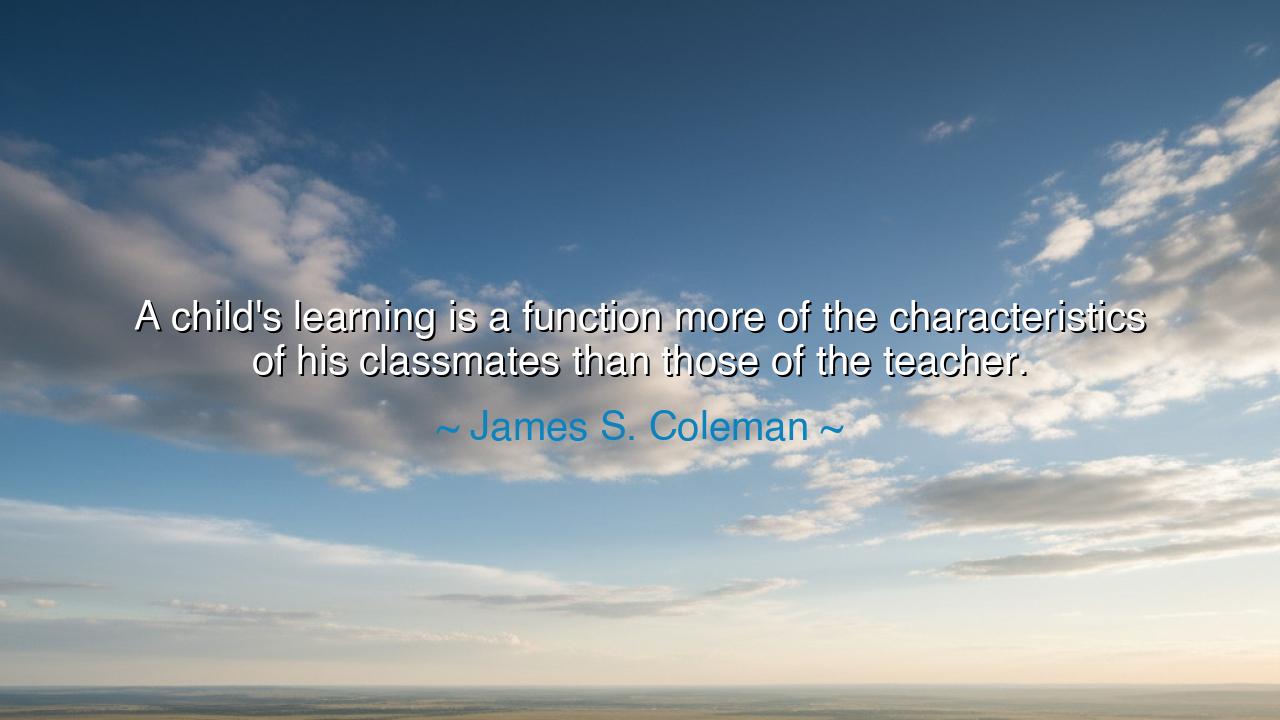
A child's learning is a function more of the characteristics of
A child's learning is a function more of the characteristics of his classmates than those of the teacher.






Hear the wisdom of James S. Coleman, who, through his study of schools and societies, gave voice to a truth that many overlook: “A child’s learning is a function more of the characteristics of his classmates than those of the teacher.” In these words, he did not diminish the sacred role of the teacher, but he revealed the hidden power of community, of companionship, of the invisible currents that shape the spirit of the young. For a teacher may light a torch, but it is among the company of peers that the flame is fanned or extinguished.
The origin of this insight lies in Coleman’s great work, the Coleman Report of 1966, a study that shook the foundations of education in America. He found that schools were not islands where teachers alone determined the fate of the child. Rather, the peer group—the classmates who sat side by side—had profound influence. A child surrounded by diligence, curiosity, and discipline was lifted upward; a child surrounded by apathy, rebellion, and despair was often dragged down. Thus, Coleman unveiled a hard truth: the society within the classroom is as mighty as the one who teaches it.
History itself bears witness to this power of peers. Consider the philosopher Plato, who sat among his fellow students in the company of Socrates. The greatness of Plato was not the gift of Socrates alone, but the sharpening of thought in dialogue with companions. His peers challenged, questioned, and inspired, and thus the Academy was born. Here we see the truth of Coleman’s words—that learning flourishes most when minds gather together, shaping one another as stones are polished by contact.
Or look to the life of Booker T. Washington, who, though guided by noble teachers, was equally formed by the community of freedmen striving alongside him. In the classrooms of Hampton and later at Tuskegee, he found strength not merely in instruction but in the example of classmates who, like him, labored for knowledge as if for bread. Their perseverance gave him courage, their hunger for learning gave him vision. Together they lifted one another toward greatness.
The meaning of Coleman’s truth is both sobering and hopeful. Sobering, because it reminds us that the classroom environment can hinder as much as it can help; hopeful, because it shows us that the power to elevate lies not in the solitary teacher alone, but in the collective spirit of students. It is a call to parents, leaders, and communities: if you would raise the child, you must raise the whole environment in which that child dwells.
O children of tomorrow, take this lesson to heart: choose your companions wisely, for they will shape your destiny more than you imagine. And if you are placed among those who lack light, strive to be the light yourself, that others may be lifted rather than dragged down. For as iron sharpens iron, so too does the spirit of one sharpen the spirit of another. Let your presence in the group be a force for growth, not decline.
Therefore, let this be the charge of every society: cultivate classrooms and communities where excellence is the common spirit, where kindness and curiosity are honored, where discipline is shared and celebrated. Support teachers, yes, but also shape the peer culture, for it is in that living crucible that children’s lives are molded. A wise society will not only train its teachers but will also guide its students to guide one another.
Thus, the words of James S. Coleman endure: “A child’s learning is a function more of the characteristics of his classmates than those of the teacher.” Let them remind us that we are never formed in isolation, but in the company we keep. Build, then, communities of wisdom, and you shall raise generations not only taught, but transformed.






AAdministratorAdministrator
Welcome, honored guests. Please leave a comment, we will respond soon